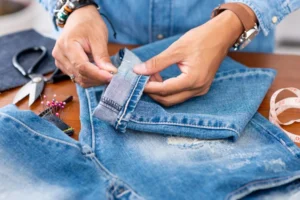Without a doubt, the hottest buzzword in fashion right now is “sustainability.” One strategy to assure sustainability is to upcycle pre-existing items. Upcycling clothes is the process of improving or creating a new object out of something that has previously been made rather than starting from scratch with new raw materials. It indicates that used clothing doesn’t end up in a landfill but instead stays in use.
Of course, there are many ways to upcycle clothing at home. But many firms are also exploring methods to incorporate upcycling clothes into their production process as the push to adopt sustainable practices grows.
A growing number of up-and-coming designers have recently joined a surge in the utilization of deadstock and already-existent textiles. This entails repurposing items such as design leftovers and deadstock clothing that would otherwise go to the trash. Therefore, it means that designers are developing collections while taking the life cycle of their pieces into consideration.
Deadstock, in a nutshell, is the unsold inventory of a product, as either fabric remnants or entire unsold outfits. Simple! This is different from finding vintage materials or used items because “deadstock” refers to items that have never been worn or even sold. Instead, you’re looking at a brand-new fabric or item that either didn’t make it into stores at all or did but wasn’t purchased by a customer to fulfill its fashion potential.
Some design companies, such as the fashion house “Reformation,” focus on upcycling clothing and create their entire output from recycled materials.

Why should more people upcycle clothes?
Over 100 billion, yes, billion, clothing pieces are made in the world each year, but unfortunately, not all of them will be worn repeatedly. For example, the UK alone discards 300,000 tons of wearable apparel each year. These astonishing figures may discourage you from wearing your stylish new clothes!
Adopting the practice of upcycling clothes by big production companies will significantly reduce waste in the fashion business and, as a result, the quantity of chemicals released in water and greenhouse gases produced when producing materials. To give you a better understanding of the scope of the issue, the fashion sector currently accounts for about 10% of global carbon emissions, on par with agriculture.
Upcycling deadstock fabrics will result in less trash production and will help lessen the amount of material that ends up in landfills.
Which fashion designers are upcycling deadstock textiles?
Up-and-coming young designers
The practice is expanding among fashion companies, and up-and-coming designers are leading the way. Sustainable materials are a priority for rising designer HRH. They introduced upcycled pieces in their Autumn/Winter 2021 collection that was launched at London Fashion Week. Moreover, the fabric of their cross-body bags is made from recycled plastic bottles.
Another firm working to improve the wasteful fashion industry is the Brooklyn-based “Fabscrap,” which collects leftover fabric from companies and designers and recycles it or resells it to other artists, designers, and makers.
Conner Ives, a designer of women’s clothing, only uses aged and deadstock clothing in his creations, and Rihanna is among his admirers. His characteristic skirts and t-shirts are colorful, patchwork creations made by repurposing and upcycling clothing. The “Horse Girl,” a gorgeously crafted scarf dress with a train that flips up and becomes a headscarf or shawl, is part of his most recent Autumn/Winter collection.
Ahluwalia, one of the most intriguing new labels, uses only deadstock materials. Designer Priya Ahluwalia explains that she works with as much old material as possible. She thinks we can protect the environment by giving new life to something that would otherwise end up in a landfill. She also used organic and recyclable fabrics.

High-end fashion houses
With so many young designers setting the pace, it was just a matter of time before the big fashion houses began to take notice. The Mulberry X Ahluwalia partnership was introduced recently. They utilize only reused leathers in their colorful collection of scarves and Portobello totes, so each item is produced in extremely small quantities.
Priya has also created a womenswear collection with the famous brand, Ganni. She says that the decision to use excess materials was influenced mainly by what Ganni really had on hand and how much of each type and fabric there was. Then, quite instinctively, she began to utilize the materials that spoke to her the most. The UK Garage scene, going out with her friends, and the female form served as the collection’s main sources of inspiration”.
Finally, high-end fashion houses are taking sustainability seriously. We still have a long way to go, but we are moving in the right direction. However, deadstock fabrics are not readily available. Cecilie Bahnsen, the famous nap dress designer, introduced the “Encore” collection in 2020, which uses leftover couture fabrics to produce small quantities of dresses. Because of the limited supply of deadstock fabrics, the clothing for the Encore collection is manufactured to order and only offered for a short period of time, up until the final meters of fabric are used.
Denim that has seen some wear has a unique charm that can’t be found in fresh pieces. Valentino and Levi’s worked together to reissue historic styles for Spring/Summer 2021 that were entirely constructed from recycled 1970s jeans. Each pair of jeans was strengthened and reissued with brand-new patches.
In addition, Miu Miu has started a partnership with Levi’s. Used jeans that have been carefully chosen are given new life in their collection. Each pair of 501s and tucker jackets is then worked on by hand to give them the perfect Miu Miu touch.
Aside from recycled denim, yarn is also gaining popularity. Gabriela Hearst, who debuted her first collection for Chloé for Autumn Winter 2021, used repurposed cashmere in her knits and excluded all synthetic fibers. Australian company Zimmermann reused old thread for all items of knitwear in its collection. The fashion brand has highlighted a number of environmental goals that they hope to accomplish by 2025.
Bottom line
The use of deadstock materials is a step in the right direction, even though it is by no means a magic cure for the fashion industry’s grave waste problem. It won’t be long before merchants want a piece of the action, given that recent polls suggest that more than 50% of shoppers are willing to spend more for sustainable clothes. on our website, you can learn more about upcycling clothes.



